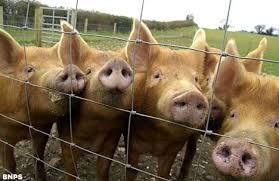|
Minerals profile in pre-and post-fed desert sheep in the Sudan

|
Original Research, C24
pii: S222877011300024-3
Babeker E.A. and Elmansoury Y.H.A.
Online J. Anim. Feed Res., 3(3): 121-128, 2013.
ABSTRACT: The objective of this study was to assess the changes in serum minerals profile in desert sheep in Sudan in relation to feed interval; pre feeding (fasting overnight), post feeding (3hrs after feeding). Twenty one yearling unsaturated males of Sudan desert sheep with an average body weight of 31.11kg were used in this study.The serum level of (Cu and Mn) was significantly high (P<0.05) in post feeding than pre feeding, while serum level of (Zn) was high in pre feeding when compared with the post feeding with percentage of changes amounting for (15%). However the serum level of (Na) was significantly (P<0.05) higher during pre feeding than post feeding whereas serum level of (Mg) was higher, while serum level of (K) was lower during pre feeding than post feeding with percentage of changes (8%) and (10%), respectively.
Key words: Mineral Profile, Feed Interval, Micro mineral, Macro mineral, Mineral requirements, Desert sheep.
|
.
.
.

.
|
|
Protein fractionation and in vitro digestibility of Azolla in ruminants
.

|
Original Research, C25
pii: S222877011300025-3
Parashuramulu S., Swain P.S. and Nagalakshmi D.
Online J. Anim. Feed Res., 3(3): 129-132, 2013
ABSTRACT: A study was undertaken to evaluate the nutritive value and digestibility of Azolla in ruminants by in vitro techniques. The crude protein, crude fibre and ether extract contents were at a level of 21.37%, 12.5% and 2.3%, respectively. The neutral and acid detergent fibre levels were about 35.4 and 23.9%, respectively. The average in vitro dry matter digestibility, in vitro organic matter digestibility and metabolozable energy contents were 79.5%, 63.8 mg/200mg and 7.36 MJ/kg DM (1759 kcal/kg), respectively. The various protein fractions A, B1, B2, B3 and C estimated by Cornell net crude protein solubility system were 18.22, 42.56, 15.15, 7.47 and 16.61% of total protein, respectively. The Azolla contained significantly higher B1 fraction followed by A, B2 and C and lowest fraction of C. Thus in view of above, present study indicated Azolla to be a good source protein supplement with 21.37% crude protein with highest B protein fractions, moderate source of energy (1759 kcal ME/kg), high dry matter and organic matter digestibilities and rich in trace minerals thus could be used as an alternate protein supplement or as supplementary protein supplement to ruminants.
Key words: Azolla, Digestibilities, In Vitro, Protein Fractions, Proximates
|
.

.

.
.
.
|
Assessment of palatability attribute of gluteaus medius steaks (beef top sirloin butt)

|
Original Research, C26
pii: S222877011300026-3
Machete J.B., Apple, J.P., Johnson, Z.B., Stackhouse, R.G. and Keys, C.
Online J. Anim. Feed Res., 3(3): 133-136, 2013.
ABSTRACT: Beef top sirloin butts (n = 48) were selected on the bases of USDA quality grade (USDA Choice or Select) and USDA yield grade category (yield grades 1 and 2 or 4 and 5) to measure Warner-Bratzler shear force (WBSF) variation within the gluteus medius (GM). Eight 2.54-cm-thick steaks were cut from the GM, with 2 steaks removed from the anterior (ANT), middle (MID) and posterior (POST) sections of the GM. One steak cut into 3 equal length steaks designated as lateral (LAT), central (CENT), and medial (MED) portions. The second steak of each pair was subsequently cut from each location pair and cooked to 71◦C in an air-impingement oven for WBSF determinations. Cooking losses were not (P>0.05) affected by yield grade or steak location; however, top Choice steaks had lower (P<0.01) cooking loss percentages than Select steaks and cooking losses were the greatest (P<0.05) and least (P<0.05) in the medial and central portions of the GM steaks, respectively. Neither quality grade category (P0.133) nor yield grade category (P = 0.485) affected the WBSF values of GM steaks, but the central portion of anterior GM steaks received the lowest (P<0.05) WBSF values, whereas the medial portion of middle steaks received the greatest (P<0.05) WBSF values (steak location × within-steak position, P<0.001). This study indicated that central portion of anterior steaks was less tough portion.
Key words: USDA Quality & Yield Grades, Instrumental Tenderness, Beef, Gluteus medius Steaks
|
 . .

.
.
|
|
Growth performance of weaner pigs fed soybean hull based diets


|
Original Research, C27
pii: S222877011300027-3
Ani A.O., Ezemagu I.E. and Ugwuowo L.C.
Online J. Anim. Feed Res., 3(3): 137-142, 2013.
ABSTRACT: A study was conducted to evaluate the response of weaner pigs to diets containing graded levels of soybean hull (SBH). Twenty-four male hybrid (large white x landrace) weaner pigs, about 6 weeks old, weighing 5.92-6.85kg were randomly divided into four groups of six pigs each using a completely randomized design (CRD). Each group was randomly assigned to one of the four isocaloric (2800kcal ME/kg) and isonitrogenous (18% crude protein) diets containing 0% (control), 10, 15 and 20% SBH for 56 days. Each treatment was replicated 3 times with 2 pigs per replicate placed on a concrete-floored pen. Daily feed intake, body weight gain, feed conversion ratio, protein efficiency ratio and feed cost per kg weight gain were determined. During the 8th week of the experiment, blood samples were collected from two pigs per treatment for haematological evaluation. Results showed that pigs fed the 10% SBH diet had higher (P<0.05) average final body weight, average weight gain and better efficiency of feed conversion than those fed 20% SBH diet. Increasing levels of SBH in the diets had no significant effect (P>0.05) on the PER values. Differences between the treatments in total digestible nutrients (TDN) were significant (P<0.05). Feed cost per kg weight gain was reduced at the 10% SBH inclusion level as compared to other SBH diets. Dietary treatments did not have adverse effect on the haematology of pigs. Pigs fed the control diet (0% SBH) and those fed soybean hull based diets had comparable performance. It was concluded that soybean hull can be included in the diet of weaner pigs at 20% level without adverse effects on the growth performance and haematological values of the animals.
Key words: Soybean Hull, Diets, Growth Performance, Weaner Pigs
|
.

.

.
|
|
Effect of feeding time on the performance of juvenile African catfish (Clarias gariepinus, burchell 1822)

|
Original Research, C28
pii: S222877011300028-3
Ani, A.O., Okpako, B.A. and Ugwuowo, L.C.
Online J. Anim. Feed Res., 3(3): 143-148, 2013.
ABSTRACT: The experiment was conducted to investigate the effect of feeding time on the performance of juvenile African Catfish (Clarias gariepinus, Burchell 1822). The experimental fish were randomly assigned to four treatment groups (different feeding time intervals) of 60 fish each in a completely randomized design (CRD). Each treatment was replicated three times with 20 fish per replicate. The fish were fed with extruded fish feeds (Catco® fish concentrate) at 3% of the fish body weight. The four treatments (feeding time) were T1 - once a day feeding time of morning hours (07.30 to 08.30) only, T2- once a day feeding time of afternoon hours (12.30 to 13.30) only, T3- once a day feeding time of evening hours (17.00 to 18.00) only and T4- twice a day feeding time of morning hours (07.30 to 08.30am) and evening hours (17.00 to 18.00) only for twelve weeks. There were significant difference (P<0.05) among treatments in fish’ final body weight( 223.63g, 200.13g, 196.33g and 168.17g for T4, T1, T3 and T2, respectively) , mean total body weight gain ( 208.97g, 184.83 , 181.07g and 153.41g for T4, T1, T3 and T2 ,respectively) , mean daily body weight gain (2.60g, 2.20g 2.16g and 1.83g for T4, T1, T3 and T2, respectively), specific growth rate (SGR) of 1.41,1.33, 1.32 and 1.26 for T4, T1, T3 and T2, respectively) and daily feed intake (3.27g, , 3.09, 2.95g and 2.54g for T4, T1, T3 and T2, respectively). There were also significant differences (P<0.05) among treatments in water temperature (26.13 oC , 25.50oC, 26.43 oC and 28.10 oC for T4, T1, T3 and T2, respectively). However, there were no significant differences (P>0.05) among treatments in dissolved oxygen (7.1 mg/l, 6.8mg/l, 7.3 mg/l and 7.5 mg/l for T1, T2, T3 and T4, respectively), water pH (7.1) , feed cost per kg weight gain (N390.00, N380.00, N379.00 and N368.00, for T1, T2, T3 and T4, respectively) and mortality rate of fish (13.38%, 11.67%, 10.00% and13.3% for T1, T2, T3 and T4, respectively). It is evident from the result obtained in the present day study that the growth performance of African catfish (Clarias gariepinus, Burchell 1822) fed twice a day( in the morning and evening hours) was superior to the performance of those fed once a day especially those fed in the afternoon hours only.
Key words: Effect, Feeding Time, African Catfish, Growth Performance
|


.
|
|
Application of Molecular Markers in Farm Animal Improvement: Prospects and Challenges

|
Original Research, C29
pii: S222877011300029-3
Ebegbulem, V.N. and Ozung, P. O.
Online J. Anim. Feed Res., 3(3): 149-152, 2013
ABSTRACT: The discovery of genetic polymorphism at the DNA sequence level has been exploited as markers to explain the observed phenotypic variability in animals. Molecular markers have proven to be more reliable than other forms of genetic markers. The overview of the applications of molecular markers in the areas of genetic diversity conservation, identification of disease carriers, parentage determination, marker-assisted selection, transgenesis, sex-determination; and the enumeration of some challenges to the application of these markers in the developing countries, especially Nigeria, form the crux of this paper. Some of the challenges include economic factors, mechanical and logistics factors, lack of funding/grants for research, IPR issues and lack of adequately trained personnel in areas of molecular genetics.
Key words: Molecular Markers, DNA Sequence, Polymorphism, Challenges
|


.
|

